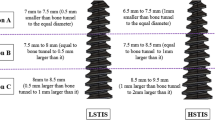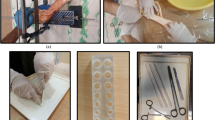Abstract
Introduction
The application of interference screws for the fixation of bone-patellar tendon-bone (BPTB) grafts is a well-established technique in anterior-cruciate ligament reconstruction. Interference screws derived from bovine compact bone are a biological alternative to metallic or biodegradable polymer interference screws.
Materials and methods
In 60 porcine specimens, the tibial part of an anterior-cruciate ligament reconstruction was performed using a BPTB graft. To secure the graft, either an 8-mm titanium interference screw or a self-made bovine interference screw (BC), or a commercial bovine compact bone screw (Tutofix®) was used. The maximum failure load was determined by means of a universal testing machine with computer interface at a testing speed of 50 mm/min. In a second test series, cyclic sub-maximal load was applied to the test specimen from 40 to 400 N with a number of 1,000 load cycles and a frequency of 1 Hz. Subsequently, the maximum failure load was determined. The stiffness of the test specimen was investigated in both test series. Each type of interference screw was tested 10 times.
Results
A secure fixation of the grafts was achieved with all interference screws. In the experiments on the maximum load to failures, the titanium screws showed significantly higher failure loads than the Tutofix® screws (P = 0.005). The stiffness of the grafts fixed with BC screws was significantly higher as compared to the fixation with Tutofix® screws (P = 0.005). After cyclic sub-maximal loading, the maximum failure load of the titanium screws was significantly higher than that of the Tutofix® screws (P = 0.033). The fixation of the BC screws showed a significantly higher failure load (P = 0.021) and stiffness (P = 0.032) than the Tutofix® screw fixation. Except for two screw head fractures and two intra-tendinous graft ruptures, the failure mode was slippage in the interface between interference screw and bone plug.
Conclusion
Interference screws derived from bovine compact bone show similar good results as the titanium interference screws. Therefore, the safety and in vivo performance of products derived from xenogenic bone should be the focus of further investigations.



Similar content being viewed by others
References
Kaeding C, Farr J, Kavanaugh T, Pedroza A (2005) A prospective randomized comparison of bioabsorbable and titanium anterior cruciate ligament interference screws. Arthroscopy 2:147–151
Pertermann J, Schierl M, Niess C, Kober R, Heinze P, Gotzen L (2000) Computer assisted planning and robot assisted reconstruction of the ACL with the CASPAR system. Arthroskopie 6:270–279
Weiler A, Scheffler S, Hoher J (2002) Transplant selection for primary replacement of the anterior cruciate ligament. Orthopade 8:731–740
Abate JA, Fadale PD, Hulstyn MJ, Walsh WR (1998) Initial fixation strength of polylactic acid interference screws in anterior cruciate ligament reconstruction. Arthroscopy 3:278–284
Pinczewski LA, Lyman J, Salmon LJ, Russell VJ, Roe J, Linklater J (2007) A 10-year comparison of anterior cruciate ligament reconstructions with hamstring tendon and patellar tendon autograft: a controlled, prospective trial. Am J Sports Med 4:564–574
Myers P, Logan M, Stokes A, Boyd K, Watts M (2008) Bioabsorbable versus titanium interference screws with hamstring autograft in anterior cruciate ligament reconstruction: a prospective randomized trial with 2-year follow-up. Arthroscopy 7:817–823
Tecklenburg K, Burkart P, Hoser C, Rieger M, Fink C (2006) Prospective evaluation of patellar tendon graft fixation in anterior cruciate ligament reconstruction comparing composite bioabsorbable and allograft interference screws. Arthroscopy 9:993–999
Martinek V, Seil R, Lattermann C, Watkins SC, Fu FH (2001) The fate of the poly-l-lactic acid interference screw after anterior cruciate ligament reconstruction. Arthroscopy 1:73–76
Robinson J, Huber C, Jaraj P, Colombet P, Allard M, Meyer P (2006) Reduced bone tunnel enlargement post hamstring ACL reconstruction with poly-l-lactic acid/hydroxyapatite bioabsorbable screws. Knee 2:127–131
Weiler A, Hoffmann RF, Bail HJ, Rehm O, Sudkamp NP (2002) Tendon healing in a bone tunnel. Part II: histologic analysis after biodegradable interference fit fixation in a model of anterior cruciate ligament reconstruction in sheep. Arthroscopy 2:124–135
Fu FH, Bennett CH, Lattermann C, Ma CB (1999) Current trends in anterior cruciate ligament reconstruction. Part 1: biology and biomechanics of reconstruction. Am J Sports Med 6:821–830
Ishibashi Y, Toh S, Okamura Y, Sasaki T, Kusumi T (2001) Graft incorporation within the tibial bone tunnel after anterior cruciate ligament reconstruction with bone-patellar tendon-bone autograft. Am J Sports Med 4:473–479
Milano G, Mulas PD, Ziranu F, Piras S, Manunta A, Fabbriciani C (2006) Comparison between different femoral fixation devices for ACL reconstruction with doubled hamstring tendon graft: a biomechanical analysis. Arthroscopy 6:660–668
Vuori I, Heinonen A, Sievanen H, Kannus P, Pasanen M, Oja P (1994) Effects of unilateral strength training and detraining on bone mineral density and content in young women: a study of mechanical loading and deloading on human bones. Calcif Tissue Int 1:59–67
Laxdal G, Kartus J, Ejerhed L, Sernert N, Magnusson L, Faxen E et al (2005) Outcome and risk factors after anterior cruciate ligament reconstruction: a follow-up study of 948 patients. Arthroscopy 8:958–964
Beevers DJ (2003) Metal vs. bioabsorbable interference screws: initial fixation. Proc Inst Mech Eng [H] 1:59–75
Weiler A, Hoffmann RF, Siepe CJ, Kolbeck SF, Sudkamp NP (2000) The influence of screw geometry on hamstring tendon interference fit fixation. Am J Sports Med 3:356–359
Weiler A, Windhagen HJ, Raschke MJ, Laumeyer A, Hoffmann RF (1998) Biodegradable interference screw fixation exhibits pull-out force and stiffness similar to titanium screws. Am J Sports Med 1:119–126
Scheffler SU, Petersen W, Weiler A (2007) Fixation of ACL grafts. Arthroskopie 2:105–114
Amis AA, Jakob RP (1998) Anterior cruciate ligament graft positioning, tensioning and twisting. Knee Surg Sports Traumatol Arthrosc 6(Suppl 1):2–12
Rosito R, Galia CR, Macedo CA, Moreira LF, Quaresma LM, Palma HM (2008) Acetabular reconstruction with human and bovine freeze-dried bone grafts and a reinforcement device. Clinics 4:509–514
Adeyemo WL, Reuther T, Bloch W, Korkmaz Y, Fischer JH, Zoller JE et al (2008) Healing of onlay mandibular bone grafts covered with collagen membrane or bovine bone substitutes: a microscopical and immunohistochemical study in the sheep. Int J Oral Maxillofac Surg 7:651–659
Beynnon BD, Amis AA (1998) In vitro testing protocols for the cruciate ligaments and ligament reconstructions. Knee Surg Sports Traumatol Arthrosc 6(Suppl 1):70–76
Nagarkatti DG, McKeon BP, Donahue BS, Fulkerson JP (2001) Mechanical evaluation of a soft tissue interference screw in free tendon anterior cruciate ligament graft fixation. Am J Sports Med 1:67–71
Seil R, Rupp S, Krauss PW, Benz A, Kohn DM (1998) Comparison of initial fixation strength between biodegradable and metallic interference screws and a press-fit fixation technique in a porcine model. Am J Sports Med 6:815–819
Schoepf C (2006) Allograft Safety: Efficacy of the Tutoplast® Process. Implants: Int Magazin Oral Implant 1:10–15
Boccafoschi F, Bosetti M, Cannes M (2005) Evaluation of bioresorbable implants from bovine bone: in vitro preliminary observations. J Appl Biomat Biomech 3:35–41
Brand J Jr, Weiler A, Caborn DN, Brown CH Jr, Johnson DL (2000) Graft fixation in cruciate ligament reconstruction. Am J Sports Med 5:761–774
Noyes FR, Butler DL, Grood ES, Zernicke RF, Hefzy MS (1984) Biomechanical analysis of human ligament grafts used in knee-ligament repairs and reconstructions. J Bone Joint Surg Am 3:344–352
Sakane M, Fox RJ, Woo SL, Livesay GA, Li G, Fu FH (1997) In situ forces in the anterior cruciate ligament and its bundles in response to anterior tibial loads. J Orthop Res 2:285–293
Rupp S, Seil R, Kohn D, Muller B (2000) The influence of avascularity on the mechanical properties of human bone-patellar-tendon-bone grafts. J Bone Joint Surg Br 7:1059–1064
Brown CH Jr, Hecker AT, Hipp JA, Myers ER, Hayes WC (1993) The biomechanics of interference screw fixation of patellar tendon anterior cruciate ligament grafts. Am J Sports Med 6:880–886
Klein SA, Nyland J, Kocabey Y, Wozniak T, Nawab A, Caborn DN (2004) Tendon graft fixation in ACL reconstruction: in vitro evaluation of bioabsorbable tenodesis screw. Acta Orthop Scand 1:84–88
Beynnon BD, Fleming BC (1998) Anterior cruciate ligament strain in vivo: a review of previous work. J Biomech 6:519–525
Zheng N, Price CT, Indelicato PA, Gao B (2008) Tibial fixation of bone-patellar tendon-bone grafts in anterior cruciate ligament reconstruction: a cadaveric study of bovine bone screw and biodegradable interference screw. Am J Sports Med 12:2322–2327
Woo SL, Hollis JM, Adams DJ, Lyon RM, Takai S (1991) Tensile properties of the human femur-anterior cruciate ligament–tibia complex: the effects of specimen age and orientation. Am J Sports Med 3:217–225
LaRochelle P, Biachi P, Spencer R (1999) Mechanical evaluation of ACL repair using BTB and allograft corticol bone interfernce screw fixation. J South Orthop ASS 8:46
Hofmann C, Schadel-Hopfner M, Berns T, Sitter H, Gotzen L (2003) Influence of processing and sterilization on the mechanical properties of pins made from bovine cortical bone. Unfallchirurg 6:478–482
Black KP, Saunders MM, Stube KC, Moulton MJ, Jacobs CR (2000) Effects of interference fit screw length on tibial tunnel fixation for anterior cruciate ligament reconstruction. Am J Sports Med 6:846–849
Pomeroy G, Baltz M, Pierz K, Nowak M, Post W, Fulkerson JP (1998) The effects of bone plug length and screw diameter on the holding strength of bone-tendon-bone grafts. Arthroscopy 2:148–152
Gerich TG, Cassim A, Lattermann C, Lobenhoffer HP (1997) Pullout strength of tibial graft fixation in anterior cruciate ligament replacement with a patellar tendon graft: interference screw versus staple fixation in human knees. Knee Surg Sports Traumatol Arthrosc 2:84–88
Weiler A, Hoffmann RF, Stahelin AC, Bail HJ, Siepe CJ, Sudkamp NP (1998) Hamstring tendon fixation using interference screws: a biomechanical study in calf tibial bone. Arthroscopy 1:29–37
Honl M, Carrero V, Hille E, Schneider E, Morlock MM (2002) Bone-patellar tendon-bone grafts for anterior cruciate ligament reconstruction: an in vitro comparison of mechanical behavior under failure tensile loading and cyclic submaximal tensile loading. Am J Sports Med 4:549–557
Zantop T, Ruemmler M, Welbers B, Langer M, Weimann A, Petersen W (2005) Cyclic loading comparison between biodegradable interference screw fixation and biodegradable double cross-pin fixation of human bone-patellar tendon-bone grafts. Arthroscopy 8:934–941
Worth A, Mucalo M, Horne G, Bruce W, Burbidge H (2005) The evaluation of processed cancellous bovine bone as a bone graft substitute. Clin Oral Implants Res 3:379–386
Trentz OA, Hoerstrup SP, Sun LK, Bestmann L, Platz A, Trentz OL (2003) Osteoblasts response to allogenic and xenogenic solvent dehydrated cancellous bone in vitro. Biomaterials 20:3417–3426
Katz J, Mukherjee N, Cobb RR, Bursac P, York A (2008) Incorporation and immunogenicity of cleaned bovine bone in a sheep model. J Biomater Appl 24:159–174
Acknowledgments
The authors wish to thank Dr. Johanna Schmitt for translating the manuscript into English.
Conflict of interest statement
There is no conflict of interest.
Author information
Authors and Affiliations
Corresponding author
Rights and permissions
About this article
Cite this article
Efe, T., Bauer, J., Herdrich, S. et al. Comparison between bovine bone and titanium interference screws for implant fixation in ACL reconstruction: a biomechanical study. Arch Orthop Trauma Surg 130, 993–999 (2010). https://doi.org/10.1007/s00402-010-1052-0
Received:
Published:
Issue Date:
DOI: https://doi.org/10.1007/s00402-010-1052-0




